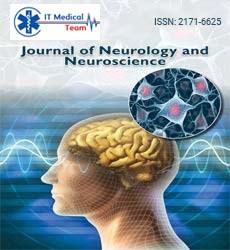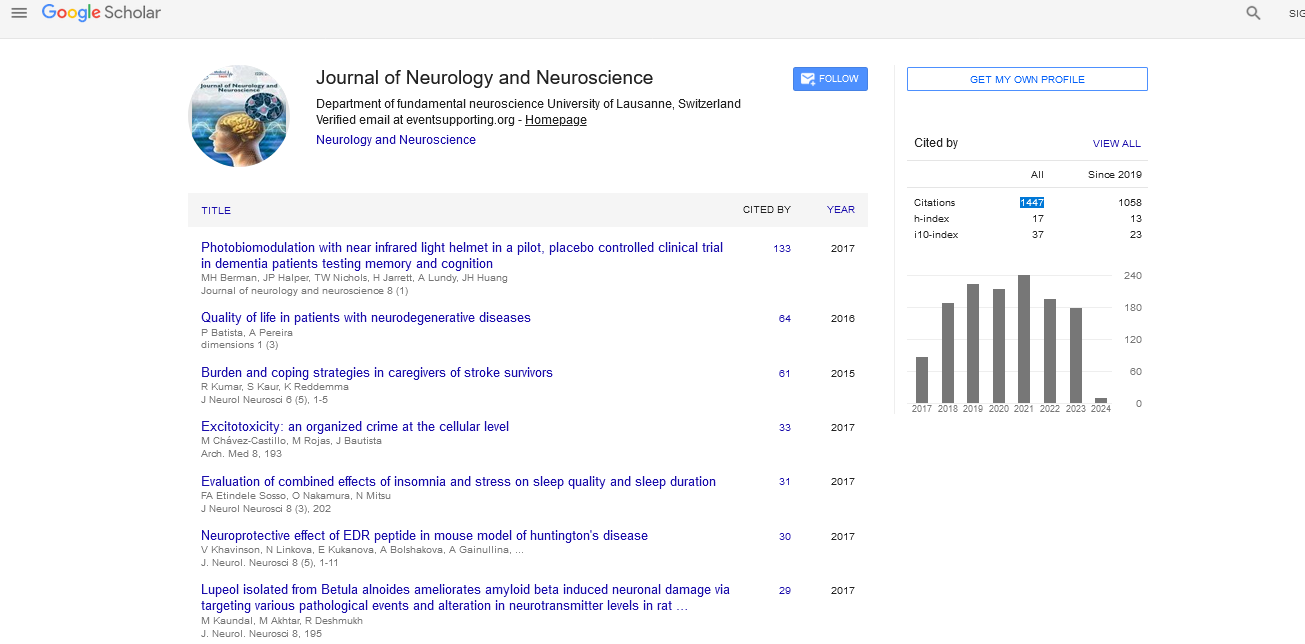Short Communication - (2025) Volume 16, Issue 1
Quantum-classical dynamics and time irreversibility in molecular brain modeling
Messina Robinson*
Department Psychology and Neurosciences, Leibniz Research Centre for Working Environment and Human Factors, 44139 Dortmund, Germany
*Correspondence:
Messina Robinson, Department Psychology and Neurosciences, Leibniz Research Centre for Working Environment and Human Factors, 44139 Dortmund,
Germany,
Email:
Received: 30-Jan-2025, Manuscript No. ipjnn-25-15568;
Editor assigned: 01-Feb-2025, Pre QC No. P-15568;
Reviewed: 14-Feb-2025, QC No. Q-15568;
Revised: 20-Feb-2025, Manuscript No. R-15568;
Published:
27-Feb-2025
Introduction
The human brain is a remarkable system, with its
intricate network of neurons and complex biochemical
processes that underlie cognition, memory, and
perception. As our understanding of the brain deepens,
one area that has gained increasing attention is the
quantum-classical dynamics within neural processes. The
notion of quantum-classical interactions, particularly
in terms of time irreversibility, offers a new framework
for understanding how molecular mechanisms in the
brain operate. In this article, we will explore the role
of quantum-classical dynamics and time irreversibility in
molecular brain modeling, shedding light on how these
phenomena contribute to the functioning of the brain
and its relationship with cognition and consciousness. In
the realms of physics, the quantum and classical worlds
are often seen as distinct. The classical world governs
macroscopic phenomena—objects that we can directly
observe and interact with, governed by deterministic
laws. On the other hand, the quantum world governs
microscopic phenomena, such as subatomic particles,
where the principles of superposition, entanglement, and
probability dominate. The behavior of quantum systems
is inherently probabilistic and governed by the principles
of quantum mechanics, whereas classical mechanics deals
with deterministic processes. In the context of the brain,
most neuroscientific models have historically relied on
classical physics, which assumes that neural activity and
the flow of information in the brain follow predictable
patterns based on classical laws of motion and chemical
interactions. However, recent research suggests that
quantum phenomena might play a role in the brain's
functionality. This has led to the development of
quantum-classical models to understand how these two
domains interact in neural systems [1].
Quantum mechanics operates at the level of individual
molecules and atoms. In the brain, this could potentially
influence processes such as neurotransmitter release,
synaptic transmission, and ion channel activity. For
example, certain proteins and enzymes that are involved
in neurotransmission might exhibit quantum properties
like superposition and tunneling. These quantum effects
could potentially influence the behavior of the molecules
in ways that classical models do not fully capture. One
area where quantum effects have been observed is in the
activity of ion channels. Ion channels regulate the flow
of ions across neuron membranes, which is crucial for
generating electrical signals and enabling communication
between neurons. Some studies have suggested that these
ion channels may display quantum coherence, where
the particle-like behavior of ions could be influenced by
quantum phenomena such as wave-particle duality or interference.
Moreover, there are hypotheses that quantum
entanglement may play a role in facilitating long-range
communication between distant brain regions. This would
allow for rapid information exchange, even over distances
that classical models would find difficult to explain. These
phenomena are still under investigation, but they suggest
that quantum effects could have a profound impact on
brain dynamics, particularly in areas related to memory
and cognition [2].
Description
The communication between neurons in the brain
depends largely on neurotransmitter dynamics. These
chemicals bind to receptors on adjacent neurons,
triggering a cascade of biochemical events that lead to
the transmission of electrical signals. It is believed that
quantum effects could influence the molecular processes
involved in neurotransmitter binding and receptor
activation. For example, the phenomenon of quantum
tunneling, where particles pass through barriers they
classically should not be able to, could be involved in
neurotransmitter release. In classical models, the release
of neurotransmitters is a process that is governed by
thermal energy, but quantum tunneling may provide
an alternative pathway that allows for faster or
more efficient neurotransmitter release. Additionally,
quantum coherence, which is the ability of a system
to maintain a stable quantum state over time, could
affect how neurotransmitters interact with receptors
and how information is encoded in neural networks.
Quantum coherence could enhance the synchronization
of neural firing patterns and facilitate more effective
communication between neurons, ultimately influencing
cognitive processes such as attention, learning, and
memory [3].
Time irreversibility refers to the fact that certain
processes cannot be reversed once they have occurred.
In classical thermodynamics, this is often discussed in
terms of entropy—the measure of disorder in a system.
The second law of thermodynamics states that in any
spontaneous process, the total entropy of a system must
increase over time, meaning that the direction of time is
inherently one-way. Time irreversibility is a fundamental
aspect of macroscopic processes, from the cooling of a
hot object to the mixing of two gases. In the brain, time
irreversibility is also an important consideration. The brain
operates in a dynamic, irreversible manner, particularly
when it comes to the encoding and retrieval of memories.
Once information is processed and stored in neural
circuits, it cannot be unprocessed or "undone" in a simple
manner. This irreversibility is a key feature of how the
brain functions—whether in terms of synaptic plasticity,
which underlies learning and memory, or in the processes
of decision-making and perception.
Memory formation is inherently time-irreversible. Once
information is encoded into neural circuits, it becomes
part of the brain’s neural architecture and cannot be
simply "erased." This irreversible process is believed to
involve the strengthening and weakening of synaptic
connections, a process known as synaptic plasticity.
Neuroplasticity enables the brain to adapt and reorganize
itself in response to new experiences, learning, and
injury. In molecular terms, time irreversibility in memory
formation is reflected in the changes in neurotransmitter
signaling and the modification of synaptic structures.
Once a memory is formed, it is encoded in the brain’s
synaptic weights, making it difficult to reverse or "unlearn"
a memory. This reflects the classical idea of irreversible
thermodynamic processes but on a biological level,
driven by molecular mechanisms. Quantum effects could
influence this irreversible process as well. For example,
quantum coherence and entanglement might help
encode and stabilize the memory in the brain’s neural
networks, ensuring that information remains accessible
and resistant to decoherence. However, just as classical
irreversible processes are governed by thermodynamic
laws, quantum-classical interactions in the brain may
introduce a level of unpredictability, ensuring that the
brain operates in a non-reversible manner, at least at the
level of neural network states and memory encoding [4].
Time irreversibility also plays a crucial role in decisionmaking
processes. Once a decision is made, the choices
are irreversible. Although we can re-evaluate decisions
over time, the specific brain states associated with
a particular decision have already passed, and they
cannot be simply "undone." The processes that lead to
a decision are influenced by the accumulation of past
experiences, emotional responses, and cognitive biases,
all of which shape our choices in an irreversible way. From
a quantum-classical perspective, decision-making might
involve both quantum superposition (where a decision
exists in multiple states until it is observed) and classical
determinism (where the final choice is determined by the
brain’s state). Time irreversibility in this context could stem
from the brain’s need to resolve these superpositions into
a final, irreversible outcome. The way these quantum
and classical dynamics interact could offer a deeper
understanding of how the brain makes decisions and how
those decisions are encoded in its neural networks [5].
Conclusion
Molecular brain modeling that incorporates quantumclassical
dynamics and time irreversibility represents
a significant leap forward in understanding brain
function. These models need to bridge the gap between
quantum mechanical behavior and classical biochemical
processes, offering insights into how they work together
to produce cognition, memory, and consciousness. One
potential approach is the development of hybrid models
that combine the deterministic principles of classical
neuroscience with the probabilistic nature of quantum
mechanics. These models could be used to simulate
neural networks that account for both the quantum
states of molecules and the classical chemical signaling
between neurons. By incorporating time irreversibility,
these models would reflect the inherently one-way
nature of processes such as memory formation and
decision-making.Quantum-classical dynamics and time
irreversibility offer a new and exciting lens through
which to view the molecular mechanisms of the brain.
By examining how quantum effects interact with classical
biochemical processes, we gain a deeper understanding
of how the brain operates on both a microscopic and
macroscopic level. Whether in memory formation, decision-making, or cognition, these interactions play a
crucial role in shaping brain function. As we continue to
explore the relationship between quantum mechanics
and classical brain processes, we can look forward to new
breakthroughs in neuroscience that could reshape our
understanding of consciousness, cognition, and the brain
itself.
Acknowledgment
None.
Conflict of Interest
None.
References
- Sergi A, Lamberto D, Migliore A. Messina A. Quantum–classical hybrid systems and Ehrenfest’s Theorem. Entropy. 2023; 25(4):602.
Google Scholar, Crossref, Indexed at
- Carpio-Martínez P, Hanna G. Quantum bath effects on nonequilibrium heat transport in model molecular junctions. J Chem Phy. 2021; 154(9).
Google Scholar, Crossref, Indexed at
- Deng B. Alternative models to Hodgkin–Huxley equations. Bull Math Biol. 2017; 79:1390-1411.
Google Scholar, Crossref, Indexed at
- Craddock TJ, Tuszynski JA, Hameroff S. Cytoskeletal signaling: is memory encoded in microtubule lattices by CaMKII phosphorylation?. PLoS Comput Biol. 2012; 8(3):e1002421.
Google Scholar, Crossref, Indexed at
- Goodson HV, Jonasson EM. Microtubules and microtubule-associated proteins. Cold Spring Harb Perspect Biol. 2018; 10(6):a022608.
Google Scholar, Crossref, Indexed at





